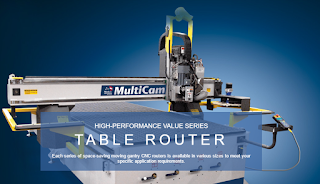 |
| http://www.multicam.com/products/cnc-routers/ |
All right. More CNC machine basics here. Today, we’re
discussing the various modes of operation your CNC machine can use.
Let’s get right to it:
Manual
Mode
Note that this differs from Manual Data Input (MDI) mode. In
manual mode, your CNC machine acts like a standard machine. You can operate it
just like you would any other machine that doesn’t use programming. You can
push buttons, turn wheels, and turn switches on or off.
The difference between manual mode and manual data input
mode is that with MDI, you can do certain things that you can’t in manual mode.
More on that in a second.
Manual
Data Input Mode (Also Called MDI or MDA Mode)
In this mode, you can do some programming and data entry.
However, everything you enter will only be done once. If you need all the
functions done again, you’ll have to program them again.
The advantage of this mode is that you can do manual
operations that simply cannot be done in manual mode. Some CNC machines, for
example, don’t have manual controls to change the spindle speed.
Single
Block Mode
Each CNC program is made of blocks. They may be numbered
something like N20, N30, and N40. When you enter this mode, just a single block
of code executes. Additionally, this means your CNC machine only stops moving
on its access. For example, the machine spindle keeps turning, and coolant
continues to flow too.
Edit
Mode
Just as it sounds, you can enter programs in your CNC
machine’s memory, or you can modify current programs. Programs are usually
organized by number, and you can make the program you want active.
You can also insert new info into the program, alter its
current info, or delete info from it. Some, but not all, CNC programs allow you
to cut, paste, find, and replace data just like you would in word processing
software.
Automatic
Mode/Program Operation Mode
Again, no surprises here. In this mode, you get to find out
how well you did with creating your program. So, take a deep breath, and
execute yours. Most CNC machines allow you to see the commands executed as they
happen. So, if you notice a mistake, you will be able to easily identify where
it is in your program.
Those are your basic modes of operation. Feelin’ ready? Awesome.
Time to give your CNC machine a try!










